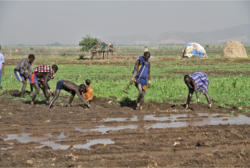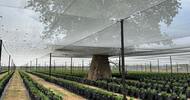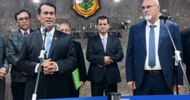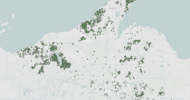
Mongabay | 16 May 2023
Dams and plantations upend livelihoods in Ethiopia’s Lower Omo River Valley
by John Cannon, Kaleab Girma
ADDIS ABABA, Ethiopia — The peoples of the Lower Omo River Valley in southwestern Ethiopia have never had an easy task in ensuring their own survival. Hot and dry, with temperamental rainfall, the region demands ingenuity and flexibility from its inhabitants. At least 200,000 people from the Bacha, Bodi, Dasanech, Hamar, Kara, Kwegu, Murle, Mursi and Nyangatom ethnic groups call this region home.
Over the centuries, these varied peoples have developed ways of life often generalized as “agropastoralist,” a term that acknowledges the centrality of both farming and herding to their existence. In practice, each has honed “quite sophisticated and diverse ways of making a living from patchy environments and unpredictable rains and flood-prone rivers,” Edward Stevenson, an assistant professor and anthropologist at the U.K.’s Durham University, said in an interview.
But recent changes to their homelands mean that many of those strategies are no longer reliable.
“Unfortunately, this way of life has vanished,” Desalegn Tekle Loyale, a Nyangatom community leader, told Mongabay. Researchers, human rights advocates, and residents like Desalegn say government projects aimed at “economic development” are laying waste to these unique ways of life and have touched off recurrent famine in the region.
The linchpin of these initiatives was the massive Gilgel Gibe III Dam built on a stretch of the Omo River above the valley. The goal was to produce electricity for use domestically and abroad, stoking Ethiopia’s rapidly growing economy in the process.
Proponents of the dam said it would also control enough of the Omo’s fickle flow for an ambitious irrigation scheme. (The Gibe III is the third dam to bottle up the flow of the Omo, and several others are planned.) Turning seemingly marginal drylands into hectare upon hectare of lucrative cash crops like sugarcane would bring jobs and more predictable sources of water for the peoples of the Lower Omo, according to the vision.
Reports suggest that few of those benefits have materialized, however, and the irreversible impacts of the project have strangled both the Omo’s seasonal floods and herders’ access to rainfed grazing land.
For its part, the government has also been largely silent on these alleged impacts. Two years of war in Ethiopia’s Tigray region, only recently ended by a ceasefire signed in November 2022, diverted attention and resources away from the layers of crises in the Lower Omo. Those familiar with the situation say malnutrition, starvation and inadequate access to health care have led to deaths in many communities.
“There was no aid, no support, and no relief. The community was forced to exchange their cattle for corn from other regions just to survive,” Desalegn said. “Unfortunately, this is still happening to this day.”
An escalating humanitarian crisis
The specter of hunger has always lingered at the margins of daily life in the Lower Omo, often as a result of cattle disease or conflict, Stevenson said. But the frequency has surged since the construction of the dam and the installation of the Kuraz sugar plantations.
Mursi, Bodi and Kwegu communities have been particularly hard-hit, especially young children and the elderly, according to a report released in February by the Oakland Institute, a California-based think tank.
“They’re just miserably hungry at the moment,” said a longtime researcher in the region who asked to remain anonymous so he could continue to work in Ethiopia.
By some accounts, forcing such a seismic shift in livelihoods may have been a driving force for these projects.
These groups typically plant corn, sorghum and beans in the bush to coincide with the fickle rains, with the harvests that depended upon them just as unreliable. At times, people would collect wild fruits and hunt in the forests along the river’s banks, especially when the crops didn’t provide enough food.
In this unpredictable landscape, the Omo was a consistent mainstay in the lives of the region’s people. Each year, the river would swell beyond its banks, inundating the parched landscape and then receding. The annual cycle left behind a timely source of sodden land in which to plant another crop. Later in the year, as the region’s dry season peaked, the crops from this “flood-retreat cultivation” would be ripening just as food stores were reaching their annual nadir.
“Food wasn’t readily available from other sources, and that tided them over,” Stevenson said.
Herding-focused groups supplemented these crops with cattle, sheep and goats, moving them in concert with the green grass coaxed from the dry earth by the region’s patchy rainfall. Hunter-gather peoples like the Kara and Kwegu would catch protein-rich fish from the river. And a healthy trade allowed the groups to exchange what they had in surplus for what they needed from others.
At the center of these livelihood strategies was the steadfast Omo. Each year, it brought the promise of hope, survival and prosperity on waters that flowed from the country’s highlands, and it slaked the thirst of the animals, the people and the land alike.
“It was more than sufficient to irrigate the farms without the need for any additional water,” said Desalegn, who is also a water engineer who has worked on several projects in the region.
But these floods ended in 2016, removing a key element that made this marginal environment inhabitable, researchers say.
‘The mere cost of development’
In 2016, after a decade of construction, crews put the finishing touches on the 250-meter (820-foot) Gilgel Gibe III Dam upriver from the valley. Holding back the water also meant that controlled irrigation flows could deliver water to the vast plantations of what would become the Kuraz Sugar Development Project planned for the valley below. The dam’s touted potential to jump-start an economic engine for Africa’s second-most populous country seemed close at hand.
But as the dam’s whirring turbines began shuttling electricity to Addis Ababa, the growing capital, and beyond, and shunting flows into irrigation canals, the age-old natural cycles of the Omo ceased, irreversibly changing the lives of the people in the Lower Omo Valley.
Speaking on the occasion of Ethiopia’s annual Pastoralist Day as the dam was being constructed in 2011, then-prime minister Meles Zenawi Asres said of Ethiopia, “Even though poverty and backwardness is a concern for the whole country, it is worse for the pastoralists.”
The anonymous researcher said the government has long seen these groups as “a big embarrassment.”
“You had these people who didn’t obey the state, they didn’t pay taxes, they didn’t do anything that the government wanted them to do,” he added.
Adane Kebede Gebeyehu, an anthropologist based at Vrije Universiteit Amsterdam in the Netherlands, wrote that such sentiments have been reinforced by “biased policy measures” depicting groups like the agropastoralists of the Lower Omo “as ‘backward’, ‘non-productive’, and ‘vulnerable’ and in need to be developed and transformed for the ‘better’.” The focus was not on preserving the unique cultures that have developed over centuries in the Lower Omo.
These biases have guided Ethiopia’s planning for decades, as the government tried to capitalize on the country’s natural resources — in this case, the energy-producing flow of water from the highlands and vast tracts of seemingly unused land. Architects of the country’s economic development argued that the dam and the Kuraz sugar plantations and factories would also provide jobs for local people and spur the provision of better roads, schools and health clinics.
“The Government has its own way of preserving the indigenous cultures of the communit[ies] all over the country,” Reta Demeke, communications head for the government’s Ethiopian Sugar Industry Group, said in an email to Mongabay. “The economic gain[s] will also benefit the communities around changing their backward way of life.”
Reta also said the food insecurity plaguing the region’s communities was the result of drought, not the impacts of the sugar plantations.
Critics of the government’s plans argue that practices such as gobbling up land formerly used periodically for farming and grazing, and requiring people to settle permanently in one place through a process known as “villagization,” forced substantial cultural changes on these communities. They also contend that the groups were largely unaware of how the dam and the plantations would alter their ways of life.
But Reta said the government’s first move, prior to the construction of the dam and establishment of the sugar plantations, was to obtain consent from the communities. He also said that the 100,000 hectares (roughly 247,000 acres) now designated for the plantation, revised down from published estimates as high as 245,000 hectares (about 605,000 acres), is “so small compared to the rest of the area, [that] scarcity of grazing land could not be a problem.”
When it comes to the loss of agricultural land, Reta said, “[F]arming is rarely practiced” by the great majority of peoples living in the Lower Omo (a contention that anthropologists dispute). He also described the region as “a vast unoccupied area” and said that because the communities had never settled down, “no land was taken from them for they live wandering from place to place.”
Putting down roots in just one place, so the thinking goes, would give them access to stable education and health care. And the government said they would be given irrigated land to farm more intensively, as well as the chance to grow sugarcane for cash income.
But many of those benefits remain unmet promises, Desalegn said. Making matters worse, the long-term drought Reta referred to has exacerbated the loss of land and flood-recession agriculture experienced by the people of the Lower Omo. Not only can communities no longer rely upon seasonal floodplains, the rangeland available to them has been cut dramatically by the incursion of the sugarcane plantations.
“With both the rain and the flood gone, this has become a serious problem,” Desalegn said.
Such a serious problem, in fact, that “chronic hunger” has become the norm, the anonymous researcher said. It’s led to desperate measures, like clearing some of the gallery forests that fringe the Omo River in an attempt to find “cool,” cultivable land. The researcher said these efforts have been “a complete failure,” leaving only ruined forests in their wake.
Now, these groups are increasingly dependent food aid delivered mostly by outside groups. The Oakland Institute has called for international action to end the ongoing famine and help these groups once again become self-sufficient.
“It is a question relevant for all societies: How are the Indigenous looked at?” Anuradha Mittal, executive director of the Oakland Institute, said in an interview. “In the larger wheels of development, which does not result in environmental protections or cultural protections … they’re seen as a mere cost to pay for development.”
Little if any of those projected economic benefits have reached the long-time residents of the Lower Omo Valley, she added.
“How can you call it development when it devastates lives and livelihoods of locals?” Mittal said.
The perception of problems
In Meles’s 2011 speech, he suggested that controlling the flow of water into the valley would actually solve a major problem for local communities.
“The Gilgel Gibe 3 Dam is developing rapidly and when it is finished the flood, which has been a huge problem for years in this region, will end forever,” he said, according to text of the speech obtained by Mongabay.
But that justification mischaracterizes the annual floods as dangerous, Desalegn said. In reality, they were seen as overwhelmingly positive by the region’s peoples.
"The locals were not troubled by the seasonal floods, which arrived at the appropriate time and lasted only a few days before they could begin farming,” he said. “The community viewed floods as a celebration, akin to a wedding.”
Planning documents suggest the government intended to provide irrigation for small plots of farmland to these communities, which by many accounts never happened.
Part of the plan was to include communities in an “outgrower” scheme that would allow smallholder farmers to grow sugarcane, which would then be funneled into the plantations’ supply chain, providing farmers with a source of income. But according to several sources familiar with this effort, when the initial participants delivered their sugarcane, the Kuraz-connected processing factories had still not been built, so there was no way to process the cane into sugar, and it was burned. The communities said they were never paid for their work, and many remain skeptical about similar efforts in the future.
“That was a total failure,” said Kebede, the anthropologist. He said he sees promise in the concept, but that its management needs a thorough overhaul. (In August 2022, the government put eight sugar enterprises up for sale to the private sector, including four of the Omo-Kuraz factories, which, according to a news report by The East African newspaper, is a bid to improve production.)
For the communities, much of the damage appears to have been done with little more than vague promise that some form of recompense is coming their way. The floods are gone, and the boundaries of the plantations have hemmed local groups into small parcels of land often cut off from what remains of the Omo.
The promised jobs are few and poorly paid, according to the Oakland Institute report. And most of the better-paying ones typically go to outsiders, leaving the locals with menial labor that pays too little to support a family amid global inflation and surging food prices.
Reta Demeke said the report mischaracterizes the reality on the ground, noting that programs have taught young people the skills necessary to acquire permanent work at the sugarcane processing factories. He said the fact that some communities have not yet benefited from the project is the result of Ethiopia being a “developing nation” with limited financial resources. It is only “a matter of time” before all of the peoples of the Lower Omo will be “reaping the fruit of the development endeavor,” he added.
But Stevenson, the university professor, and other observers point out that the development effort has cast aside local livelihoods as little more than hurdles in the way of the country’s economic success.
“It … ignores their local knowledge and their ability to grow food, and positions them as simply another kind of laborer that is growing this cash crop and receiving money that they then buy food with,” Stevenson said. “It seems that what they definitely do want is to be able to farm themselves.”
He added that people who settled in villages said they appreciated diesel-powered mills for grain. And he said some young people have now likely learned Amharic, Ethiopia’s lingua franca, potentially boosting their chances of getting a paying job.
Reta also said the project has begun to teach communities how to farm and that “some volunteers” are now using irrigation channels to farm crops like maize.
But broadly, the forced changes — through villagization, the loss of land and livelihoods, the unfilled promises — have effectively removed their rights to self-determination, critics say.
“Development is great — schooling and decent medical care and agricultural support, and all the rest,” Stevenson said. “I’m all for that, and I don’t know anybody in the Lower Omo who isn’t. But they shouldn’t be offered a choice between having that stuff and giving up their land and their own sense of the way they’d like to live.”
For Adane Kebede, it comes down to the cultural importance of their livelihoods.
“The land for them is not only survival, is not only their livelihood,” he said. “It is also their sense of ownership, sense of humanity, sense of power, sense of culture. They are practicing their cultures in the land and soil.”
As irreversible as these changes to the landscape now seem, Stevenson, Mittal and other researchers say that policy shifts from the government could ameliorate the situation for the peoples of the Lower Omo.
The need for food aid is urgent. The U.S.-based NGO World Vision reportedly delivered grain in November, though the organization did not respond to several requests from Mongabay to confirm the details.
“If the aid from World Vision didn’t come, it would have been disastrous,” Desalegn said.
The United States Agency for International Development told Mongabay in an emailed statement that 135,000 people in the South Omo Valley received food aid through USAID’s partner, the Joint Emergency Operation, in the first months of 2023.
“You can’t turn the clock back, and nobody’s going to magic that dam away,” Stevenson said. The emphasis should now be on helping communities “live with more dignity than they’re able to right now.”
“That would include allowing local people who want to farm [and have] access to irrigation water and land to grow food crops on, as opposed to starving beside sugarcane,” Stevenson said.
Another possibility relates to the progress of the plantation project, the anonymous researcher said. The boundaries of the plantations have been set, but the area hasn’t been fully cleared.
“Not clearing those areas and moving the boundaries off of these Mursi and Bodi grazing areas would be great,” the researcher added.
In the end, though, such wholesale changes to the landscape for the sake of “development” should not take place without the input of the people who are most affected by them, Stevenson said.
“These folks … have a right to be included in development,” he said. “They also are part of a large number of people around the world whose own interests in their survival and their … food sovereignty are consistent with the protection of more biodiverse one world — indeed, a world that is more habitable for all of us.”













